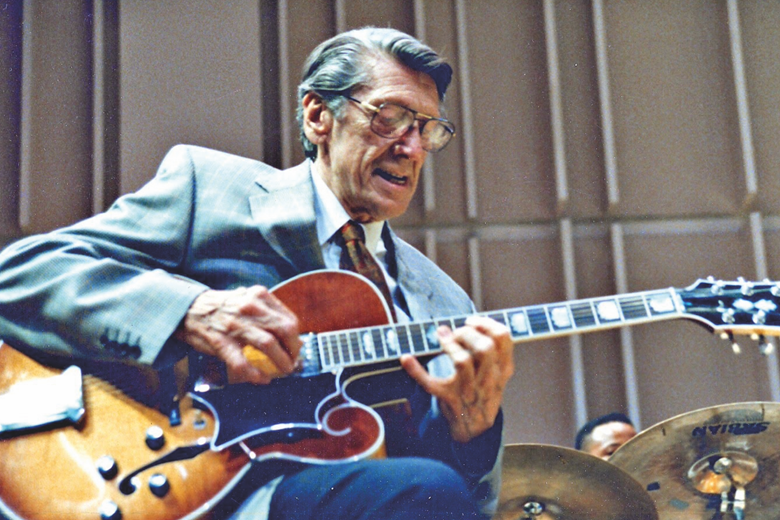Tal Farlow: Lord of the strings
Stuart Nicholson
Thursday, April 17, 2025
Stuart Nicholson looks back at the career of that most underrated of jazz guitar masters, Tal Farlow, who often preferred fishing to soaking up the limelight

Acknowledged as a defining figure in 1950s jazz guitar, Tal Farlow emerged as a member of vibist Red Norvo’s Trio with Charles Mingus on bass in 1950. The recordings they made between 1950-51 for the Discovery label assured his place in jazz history, regarded by many as among the finest small group recordings in all of jazz.
While most young guitar modernists such as Barney Kessel, Herb Ellis and Johnny Smith were following a broadly similar path, influenced by the likes of Charlie Christian and Charlie Parker, it was Farlow who was truly setting the pace on jazz guitar.
Collectively, Norvo’s trio represented virtuosity writ large, but it was Farlow’s control and ease of execution, even at the fastest tempi, that caught the ear – had the guitar ever been played this fast, so effortlessly and with so much meaning before? Close listening reveals a thorough command of bebop harmony and rhythms; an ability to effortlessly string chains of arpeggios together to give contrast to his single note lines; a very personal way of using large intervals and a highly developed melodic sense that allowed him to spin ideas across bar lines and chord changes. But there was one extra ingredient that made his playing so compelling, summed up by fellow guitar legend Johnny Smith: “That kind of playing comes from the heart and soul.”
Farlow’s impact on his fellow guitarists was profound. Most Charlie Christian disciples at the time predominantly used downstrokes, but Farlow used alternate (down-up) picking – he had completely rethought his right-hand technique.
As a series of widely-admired albums for Norman Granz’s Clef and Verve labels followed, he was voted the new star guitarist in the 1954 DownBeat Critics Poll and took top spot in the magazine’s guitar polls of 1956 and 1957. But after a run at Sy Barron’s Composer club with pianist Eddie Costa and bassist Vinnie Burke in 1958 (the trio is captured on the Verve label), he was not seen or heard of on the New York jazz scene for almost a decade (although he continued recording for the Verve label until December 1959).
Farlow's playing came from the heart and the soul
Recently married, he had settled for a simpler life at his riverside retreat in Sea Bright, New Jersey. Returning to his old trade of sign-writing which he had pursued since apprenticing after high school (he was 22 when he took up the guitar), he could enjoy boating, fishing and playing local gigs. He seemed to like it that way.
Then, in October 1967, he was finally persuaded by DJ Mort Fega to open at the Frammis club on Manhattan’s East Side. During his absence from the New York scene a mystique had developed around him, and without his knowing, he had become something of a living legend. “It didn’t take long for word to get around that the guitarist was back in town and people came from near and far to hear [him],” Fega told DownBeat. “He turned everybody around… to a man, everyone agreed that, if possible, he was even more of a monster on his instrument than they remembered.” Then Farlow was gone.
To all intents and purposes, he was a homebody: “I don’t need expensive things or a hectic life, so I stay in Sea Bright” he told DownBeat, and his activity reflected his in-out relationship with the big time. Then, on 5 July 1969 he appeared at the Newport Jazz Festival as a member of the Newport All-Stars, briefly reuniting him with Red Norvo, and he recorded The Return of Tal Farlow; it sounded as if he had never been away, saying, “I guess if anything I’ve gotten faster in my old age.” He was 48 at the time. Participating in several more albums for the Prestige label, he appeared again at Newport, this time in a duo with Jim Hall, on 30 June 1973.
On 4 July 1976 he appeared in Carnegie Hall in a 'Salute to Tal' concert as part of the Newport Jazz Festival in New York and the following month he began an association with Concord records. Between 1980 and early 1981, producer Lorenzo DeStefano completed a film documentary on Farlow’s life, Talmage Farlow, that made its world premiere at the Carnegie Hall Cinema in New York City: “One of the most striking portrait documentaries ever made, a classic,” said Jazz Educator's Journal.
As a result of DeStefano’s documentary and the publicity it attracted, the clamour to hear Farlow play became too great, even for a notorious homebody like Farlow to ignore. It resulted in his venturing from his Sea Bright retreat more and more often for international tours and festival appearances, including, in the early 1990s, replacing Barney Kessel in the Great Guitars line-up alongside Herb Ellis and Charlie Byrd, with whom he toured until shortly before his death. A charming and genuinely modest man, he died on 25 July 1998, aged 77, without once having believed he was the true jazz great that he really was.
This article originally appeared in the May 2025 issue of Jazzwise – Subscribe Today


